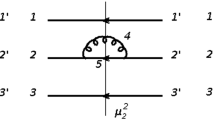Summary
The quark is defined as a flavour vector state in the colour space and the antiquqrk as a vector in the dual space. The observables appear to be scalar in the colour space built even with a vector and a covector (meson) or with a vector and a pseudovector (baryon). The pseudovector seems to be related to the Pauli-principle existence and allows a comprehension of the distinction between baryons and mesons. The investigation of the strong interaction as exchange of gluons between quarks leads to two fundamental processes: the fusion-fission of mesons and the triple rearrangement of three mesons into a baryon-antibaryon pair. The JOZI rule which forbids the break of a junction is thus recovered. The possible existence of different multiquark states is then considered from the topological point of view.
Riassunto
Il quark è definito come uno stato vettoriale di sapore nello spazio di colore e l'antiquark come un vettore nello spazio duale. Le osservabili appaiono essere scalari nello spazio di colore costruito anche con un vettore e un covettore (mesone) o con un vettore e uno pseudovettore (barione). Lo pseudovettore sembra essere in relazione con l'esistanza del principio di Pauli e permette la comprensione della distinzione tra barioni e mesoni. L'indagine sull'interzione forte, come lo scambio di gluoni tra quark, porta a due processi fondamentali: la fusione-fissione dei mesoni e la tripla sistemazione di tre mesoni entro una coppia barione-antibarione. Si riporta così in uso la regola di JOZI che impedisce la rottura di una giunzion. Si riconsidera poi la possibile esistenza di stati di multiquark diversi, dal punto di vista topologico.
Резюме
Кварк определяется как векторное состояние, обладающее ароматом, в цветном пространстве, а антикварк как вектор в дуальном пространстве. Оказывается. наблюдаемые величины представляют скаляр в цветном пространстве, построенном с вектором и ковектором (мезон) или с вектором и псевдовектором (барион). Псевдовектор, по-видимому, связан с существованием принциоа Паули и позволяет, вообще говоря, различить барионы и мезоны. Исследование сильного вааимодеиствия, как обмена глуонами между кварками, приводит к двум фундаментальным процессам: синтез-деление мезонов и тройная перегруппировка трех мезонов в барион-антибарионную пару. Заново устанавливается правило JOZI, котрое запрещает разрыв соединения. Затем с топологической точки зрения рассматривается возможное существование различных многокварковых состояний.
Similar content being viewed by others
References
C. Rebbi:Phys. Rep. C,12, 1 (1974).
G. Veneziano: inColour Symmetry and Quark Confinement, Proceedings of the XII Rencontre de Moriond, March 6–18, 1977, edited byTran Thanh Van.
X. Artru:Nucl. Phys. B,85, 442 (1975).
M. Imachi, S. Otsuki andF. Toyoda:Prog. Theor. Phys.,52, 341 (1974);54, 280 (1975);55, 551 (1976).
Y. Nambu: talk presented at theAmerican Physical Society Meeting of Chicago, January 1970, EFI 70-07; concluding talk of theXIX International Conference on High-Energy Physics (Tokyo, 1978).
M. Imachi, S. Otsuki andF. Toyoda:Prog. Theor. Phys.,57, 517 (1977).
H. Harari:Phys. Rev. Lett.,22, 562 (1969);J. Rosner:Phys. Rev. Lett.,22, 689 (1969).
G. F. Chew: inProceedings of the Workshop on Baryonium and Other Unusual Hadron States, Orsay, France, June 21–22, 1979.
G. F. Chew:Phys. Rep. C,41, 263 (1978).
G. F. Chew, B. Nicolescu, J. Uschersohn andR. Vinh Mau: preprint CERN TH-2635 (1979).
A. Zichichi:Riv. Nuovo Cimento,2, No. 14 (1979).
E. Elbaz:Traitement graphique de l'algèbre de Racah et de l'analyse vectorielle, Cours Université de Lyon (1979).
E. Elbaz andJ. Meyer: Université de Lyon, Report LYCEN 7969 (1979).
E. Elbaz andB. Castel:Graphical Methods of Spin Algebras (New York, N. Y., 1972).
E. Predazzi: lectures given at the University of Lyon, Report LYCEN 7835.
H. Högaasen andP. Sorba:Nucl. Phys. B,145, 119 (1978).
H. M. Chan:Proceedings of the XIX International Conference of High-Energy Physics (Tokyo, 1978).
T. F. Kycia:Proceedings of the XIX International Conference of High-Energy Physics (Tokyo, 1978).
L. A. P. Balazs andB. Nicolescu: inProceedings of the Workshop on Baryonium and Other Unusual States, Orsay, France, June 21–22, 1979.
Author information
Authors and Affiliations
Additional information
Traduzione a cura della Rediazione.
Перевебено ребакцией.
Rights and permissions
About this article
Cite this article
Elbaz, E., Meyer, J. A geometrical approach to the hadrons and the baryonium. Nuov Cim A 57, 271–293 (1980). https://doi.org/10.1007/BF02776486
Received:
Published:
Issue Date:
DOI: https://doi.org/10.1007/BF02776486




